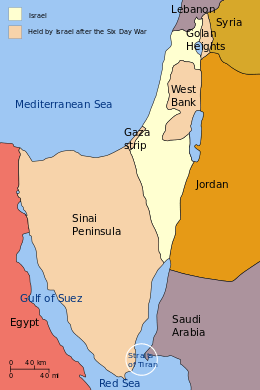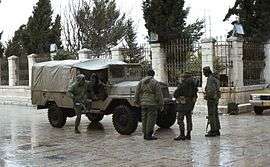Israeli Military Governorate
| Israeli Military Governorate | ||||||
| הממשל הצבאי Ha-Memšal Ha-Tsvaʾi | ||||||
| ||||||
| ||||||
 | ||||||
| Capital | Not specified | |||||
| Languages | Hebrew (official), Arabic | |||||
| Government | Military government | |||||
| History | ||||||
| • | Six Day War | 5 June 1967 – 10 June 1967 | ||||
| • | Egypt–Israel Peace Treaty | 26 March 1979 | ||||
| Currency | Israeli Lira | |||||
The Israeli Military Governorate was a military government established following the Six Day War in June 1967, in order to govern the civilian population of the West Bank, the Gaza Strip, the Sinai Peninsula and the Golan Heights. The governance was based on the Fourth Geneva Convention, which provides guidelines for military rule in occupied areas. East Jerusalem was the only exception from this order, and it was effectively added to Jerusalem municipal area as early as 1967, and extending Israeli law to the area (effectively annexing it).
The Egypt–Israel Peace Treaty led Israel to give up the Sinai Peninsula in 1982 and transform the military rule in the Gaza Strip and the West Bank into the Israeli Civil Administration in 1981. The Western part of Golan Heights was effectively annexed by Israel the same year, thus abolishing the Military Governorate system entirely.
Establishment
The Six Day War began on June 5, 1967, with Israel launching surprise strikes against Egyptian air-fields in response to the mobilization of Egyptian forces on the Israeli border. A period of high tension had preceded the war. In response to PLO sabotage acts against Israeli targets,[1][2][3] Israel raided into the Jordanian-controlled West Bank[4][5] and initiated flights over Syria, which ended with aerial clashes over Syrian territory,[6] Syrian artillery attacks against Israeli civilian settlements in the vicinity of the border followed by Israeli responses against Syrian positions in the Golan Heights and encroachments of increasing intensity and frequency into the demilitarized zones along the Syrian border,[7] and culminating in Egypt blocking the Straits of Tiran,[8] deploying its troops near Israel's border, and ordering the evacuation of the U.N. buffer force from the Sinai Peninsula.[9][10]
Within six days, Israel had won a decisive land war. Israeli forces had taken control of the Gaza Strip and the Sinai Peninsula from Egypt, the West Bank, including East Jerusalem, from Jordan, and the Golan Heights from Syria. The resulting expansion of territory led to the establishment of a military government on those territories to run the affairs of Arab populations falling under Israeli military rule. Overall, Israel's territory grew by a factor of three, including about one million Arabs placed under Israel's direct control in the newly captured territories. Israel's strategic depth grew to at least 300 kilometers in the south, 60 kilometers in the east, and 20 kilometers of extremely rugged terrain in the north, a security asset that would prove useful in the Yom Kippur War six years later.
Governance

Effectively, from June 1967 Israel has exercised a military rule in subjected territories of the West Bank, Gaza Strip, Sinai Peninsula and Golan Heights, based on the Fourth Geneva Convention, which is proving guidelines for military rule in occupied areas. East Jerusalem was the only exception from this order, and it was effectively added to Jerusalem municipal area as early as 1967, and extending Israeli law to the area (effectively annexing it).
Dissolution
The military government's authority was effectively cancelled with the Egypt–Israel Peace Treaty, which led it to give up the Sinai Peninsula in 1982 and transform the military rule in the Gaza Strip and the West Bank into Israeli Civil Administration in 1981. The creation of a civil administration for the West Bank and Gaza Strip was included within the Camp David Accords signed by Egypt and Israel in 1978.[11] The nature of this civil administration body was defined in Military Order No. 947, by the 1981 military government of the West Bank and Gaza. The Western part of Golan Heights was effectively annexed to Israel the same year, thus abolishing the Military Governorate system entirely.
See also
References
- ↑ Israel, Army and defense - A dictionary, Zeev Schiff & Eitan Haber, editors, Zmora, Bitan, Modan, 1976, Tel Aviv Hebrew
- ↑ Rubin, Barry M. (1994). Revolution Until Victory?: The Politics and History of the PLO. Harvard University Press. p. 11. ISBN 9780674768031.
- ↑ Middle East: Incident at Samu, Time, Nov. 25, 1966
- ↑ Tessler, Mark (1994). A History of the Israeli-Palestinian Conflict. John Wiley & Sons. p. 378. ISBN 0253208734.
Towards the War of June 1967: Growing tensions in the region were clearly visible long before Israel's November attack on Samu and two other West Bank towns. An escalating spiral of raid and retaliation had already been set in motion...
- ↑ Shemesh, Moshe (2007). Arab Politics, Palestinian Nationalism and the Six Day War: The Crystallization of Arab Strategy and Nasir's Descent to War, 1957–1967. Sussex Academic Press. p. 118. ISBN 1845191889.
The Jordanian leadership's appraisal of the repercussions of the Samu' raid was a major factor in King Husayn's decision to join Nasir's war chariot by signing a joint defense pact with Egypt on May 30, 1967. This was the determining factor for Jordan's participation in the war that would soon break out.... Convinced after the Samu' raid that Israel's strategic goal was the West Bank, Husayn allied himself to Nasir out of a genuine fear that, in a comprehensive war, Israel would invade the West Bank whether or not Jordan was an active participant.
- ↑ Maoz, Zeev (2009). Defending the Holy Land: A Critical Analysis of Israel's Security and Foreign Policy. The University of Michigan Press. p. 242. ISBN 0472033417.
- ↑ Maoz, Zeev (2009). Defending the Holy Land: A Critical Analysis of Israel's Security and Foreign Policy. The University of Michigan Press. p. 84. ISBN 0472033417.
By the fall of 1966 and spring of 1967, things seemed to be getting out of hand. Israeli-initiated encroachments into the demilitarized zones (DMZ) along the Syrian border became more frequent and intense. Israeli leaders made repeated statements to the effect that the Syrian regime was directly responsible for the border clashes and that Israel may act directly against the Syrian regime
- ↑ The Encyclopedia of the Arab-Israeli Conflict: A Political, Social, and Military History. ABC-CLIO. 2008. Retrieved 2013-05-13.
- ↑ Bar-On, Mordechai (2004). A Never-Ending Conflict: A Guide To Israeli Military History. Greenwood Publishing Group. p. 181. ISBN 0275981584.
- ↑ Shlaim, Avi (2012). The 1967 Arab-Israeli War: Origins and Consequences. Cambridge University Press. p. 106. ISBN 9781107002364.
Nasser responded by taking three successive steps that made war virtually inevitable: he deployed his troops in Sinai near Israel's border on 14 May; expelled the UNEF from the Gaza Strip and Sinai on 19 May; and closed the Straits of Tiran to Israeli shipping on 22 May.
- ↑ Schmidt, Yvonne (2001). Foundations of Civil and Political Rights in Israel and the Occupied Territories. GRIN Verlag. p. 348. ISBN 978-3-638-94450-2.
External links
| Wikimedia Commons has media related to Israeli Military Governorate. |

